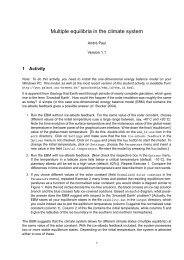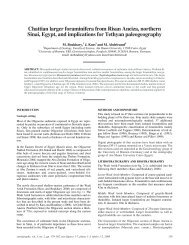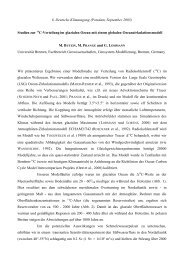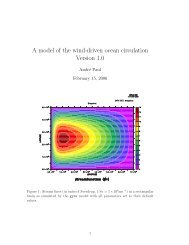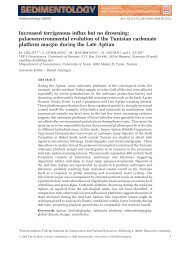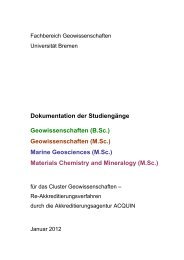Forschung im HLRN-Verbund 2011
Forschung im HLRN-Verbund 2011
Forschung im HLRN-Verbund 2011
- Keine Tags gefunden...
Sie wollen auch ein ePaper? Erhöhen Sie die Reichweite Ihrer Titel.
YUMPU macht aus Druck-PDFs automatisch weboptimierte ePaper, die Google liebt.
188First-Principles Approaches to the Molecule-Insulator InterfaceAdsorption of Organic Molecules on Wide-Gap InsulatorsW. Chen, C. Tegenkamp, H. Pfnür, Institut fürFestkörperphysik, Leibniz-Universität HannoverAbstract• The understanding of the organic moleculeinsulatorinteraction is central to a wide varietyof applications (molecular electronics, catalysis,etc.)• A microscopic picture of the molecule-insulatorinterface can be obtained from state-of-the-artfirst-principles approaches.• The massively parallel computing systems at<strong>HLRN</strong> are ideal for first-principles modeling. Thecomputation can be distributed over a large numberof nodes.We are living in a world surrounded by surfaces.There are various surfaces, either metallic or insulating,with which we are constantly interactingin our daily life. Reactions on surfaces are ubiquitous,for example, the rusting and the corrosionof metal surfaces due to oxidation. Over the pastfew decades, great effort has been dedicated tounderstanding the physical and chemical phenomenaoccurring at surfaces and the interfaces of twophases. Heterogeneous catalysis is one of thepr<strong>im</strong>e concepts and main applications in the fieldof surface chemistry which was pioneered by PaulSabatier and Fritz Haber. Tremendous progresshas been achieved since then in the understandingof microscopic characteristics of surfaces andthe reactions at surfaces, which is benefited fromnovel exper<strong>im</strong>ental techniques and modern theoreticalapproaches. The advances in surface scienceboost the development of semiconductor devicefabrication (e.g. epitaxial growth, chemical vapordeposition and atomic layer deposition, selfassembledmonolayer based molecular electronics,catalysts, and fuel cells).One central ingredient in a wide class of applicationsin surface science (such as heterogeneouscatalysts and self-assembled monolayers)is the molecule-surface interaction. Notably, GerhardErtl’s contribution to the investigation of COmolecules adsorbed at Pt surfaces earned h<strong>im</strong> aNobel Prize of Chemistry in 2007. Over the lastdecade, adsorption of molecules at metal surfacesand semiconductors gained broad attention whichwas st<strong>im</strong>ulated by their relevance in catalysis andmolecular electronics. In contrast, there are considerablyfewer studies of the molecule-insulator interfaces.Adsorption of organic molecules at widegapinsulator surfaces is often unreactive and correspondsmostly to weak physisorption as long asthe surface is free of defects. For instance, thefeatures of the frontier molecular orbitals of a pentacenemolecule are preserved upon its adsorptionat Cu-supported NaCl films as is resolved by scanningtunneling microscopy. Due to the inertnessof the wide-gap insulator surfaces, they are excellentcandidates for supporting substrates in manychemical and technical applications.Specifically, revisiting the interface between organicmolecules and wide-gap insulators is st<strong>im</strong>ulatedby the intriguing features of a separation processin the mining industry. It has been observedthat the addition of certain organic moleculescan trigger the separation of various mineralssuch as halite (NaCl), sylvite (KCl) and kieserite(MgSO 4·H 2 O) effectively by electrostatic forces inan inhomogeneous electrical field. The electrostaticseparation process is plausibly explained bya charge transfer model. Without adsorbates, electronicexcitation is practically <strong>im</strong>possible at roomtemperature according to the Fermi-Dirac statistics.This situation is modified by the unoccupiedstates generated by the adsorbate at the insulatorsurface. The electrons can effectively be excited tothese unoccupied molecular states provided thatthe excitation energy is sufficiently small. Whentwo adsorbate covered surfaces are brought intocontact, electrons can hop from one side to theother. A contact voltage drop across the interfaceresults from the net charge transfer, which is supposedlyresponsible for the electrostatic separationprocess.A precise control of the efficiency of the separationprocess requires not only the accurate knowledgeof the organic molecules and the host insulator,but also the microscopic picture of themolecule-insulator interaction. Although the propertiesof the conditioner molecules (such as benzoicacid and its phenolic derivatives) and the rocksaltare well-known, the detailed mechanism of theinteraction between the organic molecules and theinsulating surface was not yet identified. The surfacesof NaCl or KCl grains are never free of defects.These defects are assumed to have enormous<strong>im</strong>pact on the adsorption configuration andthe electronic structure of the adsorbed system.In this project, we use first-principles calculationsto investigate the adsorption of benzoic acid andits various phenolic derivatives at wide-gap insulators(e.g. NaCl and KCl surfaces), in an effort todemystify the contact charging effect between saltPhysik




